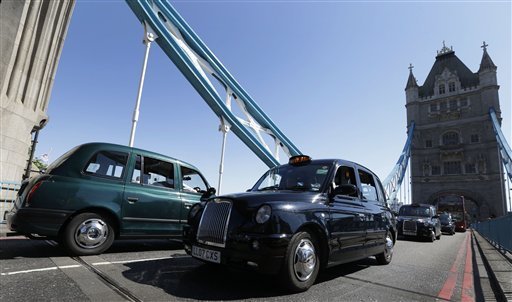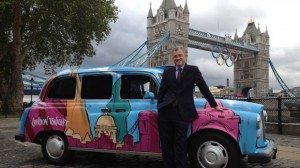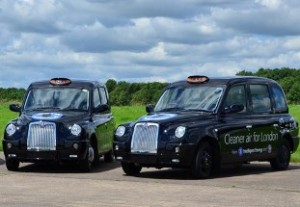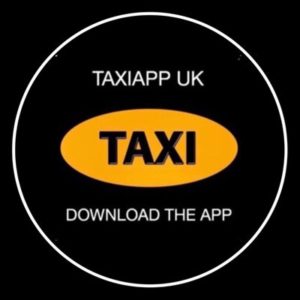by News Desk | Jul 25, 2012 | London News

Taxi Drivers drive slow across Tower Bridge demonstrating against exclusion from the Olympic Lane Network
LONDON (AP) — Confusion, frustration and delays reigned on London’s congested roads Wednesday, as lanes reserved for Olympic VIPs came into force two days before the start of the games.
Traffic jams blocked some of the main routes into the city as the wildly unpopular “Games Lanes” took effect. The 30 miles (48 kilometers) of lanes are to operate from 6 a.m. to midnight throughout the games, and cars or taxi cabs that stray into them face a 130-pound ($200) fine.
Thousands of London drivers have switched to public transport, only to encounter severe delays on several Underground subway lines caused by power supply problems and signal failures. Severe delays were reported on the city’s Central and Hammersmith subway lines with ripple delays affecting other lines.
British officials — who have been advising Londoners for weeks to plan ahead, allow extra time or just stay home — advised a stiff upper lip.
“There will be a lot of disruption and London is a congested city anyway,” Transport Secretary Justine Greening told BBC television.
As host city, London is as cosmopolitan as they come, but transport is its weak spot: Traffic often clogs up on its narrow, historic roads, bus schedules can change at a moment’s notice, and the famous Underground suffers from daily delays and infrastructure that in parts is more than a century old.
For a city of its size, London has surprisingly few highways or wide thoroughfares, which means that most roads have multiple traffic lights and pedestrian crossings. Olympics organizers have repeatedly urged people to avoid driving their cars, to walk and bike ride around, and for spectators to go to events using public transport.
“Drivers do have somewhere to go, but it’s been a bit confusing,” said Paul Watters, head of road policy at the British Automobile Association. “We know it’s going to be tricky and difficult, and it’s bound to be full of teething problems. We’re almost there now so hopefully it will be better.”
Critics argue that the Olympic lanes — open only to athletes, officials, journalists, emergency services and games marketing partners — are elitist and make life difficult for everyone else. Britain relies on traffic cameras to spot infractions, so many people won’t know they’ve been ticketed till the bad news arrives in the mail.
To make things even more confusing, the lanes will be open to regular drivers if Olympic traffic is light, with the information displayed on electronic signs.
The International Olympic Committee had specifically demanded the lanes be created after learning lessons from previous games — one of the worst being Atlanta in 1996, where bus drivers got lost and some athletes arrived moments before their events.
In London, some of the loudest opposition to the Olympic VIP lanes has come from the city’s cabbies, who have staged two recent demonstrations that brought central London traffic to a standstill. They say being banned from Olympic lanes jeopardizes their business by creating much longer — and costlier — cab rides for customers.
“We’re not going to be able to drop passengers where they want to go,” said Lee Osborneof the United Cabbies Group, which protested with about 50 cabs at Tower Bridge on Tuesday. “Traffic in London is pretty bad as it is, and now passengers are going to suffer with the meter just ticking away.”
London’s Tube network is the most popular way to get across town, but it groans with age — its first line, the Metropolitan, opened in 1863. Today, that line still runs alongside more than a dozen others in a half-modernized system that handles roughly 12 million trips a day.
Officials are expecting up to 15 million subway trips a day during the Olympics.
In all, the British government has injected 6.5 billion pounds ($10 billion) to upgrade the transport network for the games. Whether that is enough is still an open question.
“It can’t even cope in normal times, all it takes is one problem and the whole system gets paralyzed,” said Tony Shelton, an accountant who was riding the Northern line. His journey was only slightly delayed but he said: “I’ll probably avoid coming into town.”
by News Desk | Jul 25, 2012 | London News
A man has dived headfirst off Tower Bridge during a protest by London taxi drivers against their ban from using Olympics Games Lanes.
The group of drivers travelled slowly across Tower Bridge, tooting their horns.
A man was arrested after jumping from the bridge into Thames.
Last week taxi drivers brought Parliament Square to a halt, claiming they should be able to use the lanes as well as officials and athletes.
“Start Quote
Please do not leave your taxi unattended! We have reports that one taxi driver has done just that in spectacular fashion!”
Taxi driver on Twitter
The diver, believed to be a taxi driver, was pulled from the river by police. A man had previously contacted media organisations warning he was going to attempt the stunt.
A Metropolitan Police spokesman said: “Around 4pm a man who was taking part in a planned demonstration jumped into the River Thames from Tower Bridge.
“Officers from the marine policing unit rescued the man. He has been arrested for a public order offence.”
A photograph posted on Twitter appeared to show the man entering the water headfirst in a streamlined diving position.
One taxi driver then Tweeted: “Please do not leave your taxi unattended! We have reports that one taxi driver has done just that in spectacular fashion!”
The diver wore what appeared to be a white Stetson hat
A BBC reporter said the man was almost hit by a tourist ferry in the water.
Traffic was again brought to a standstill during the protest, and there was a noticeable police presence.
A BBC correspondent estimated that about 50 cabs took part, with drivers sounding their horns in unison to make their presence felt.
The United Cabbies Group said on Twitter that it was happy with the turnout, which saw about six police vans at the scene.
Leon Daniels, Transport for London’s managing director of surface transport, said: “The first taxi protest was attended by a tiny minority of drivers, and they do not represent the views of the vast majority of London’s taxi drivers.
“It is a real shame that people who claim to represent some of the honest and most hard-working people in London, the taxi trade, have acted in this way.”
by News Desk | Jul 25, 2012 | London News

“Have you done the Knowledge?”… “Will you go south of the river”… “You’ll never guess who I had in the back of my cab the other day”… Seriously, the jokes flying in my direction have been so funny I almost crashed my cab.
That’s right – my cab. Just as the cold reality of the Olympic lanes threatens to bring London to a grinding halt, I’ve been given the job of heading out into the thick of it – and a cab to do it in. But, my friends, this is no ordinary black cab.
Let me say here that I love ordinary black cabs; not only are a London trademark, if you’ve ever got into a taxi in other big cities round the world, you’ll know that our cabbies are, bonnet and bumper, ahead of them all. However, I’m delighted to say that my cab is not black. It’s blue. And green… and orange, yellow and pink. Seriously, Rice and Lloyd-Webber should write a musical about it… ‘Close Every Door (but don’t slam it)’. You can have that, Sir Tim.
The cab was black when London Tonight bought it. After a long life on London’s roads, it look set for a life of ferrying fare-passengers around a town north of Watford but ‘M116 VMK ‘ then caught our eye and its future was suddenly looking a lot more ‘colourful’. Taken to a artist’s studio (mechanic’s garage) in Camden, it was then given a whole new look, courtesy of the Graffiti Kings. I think you’ll agree that the result is eye-catching. While I’ve never been a huge fan of the sort of mindless spraying of walls, bus-stops and tube carriages, the Graffiti Kings are artistic royalty and I love what they’ve done to my cab: a traditional London theme in vibrant colours, with a modern twist. (Brian Sewell, your job is safe.)
Next question then – what are we going to do with it? Well, the idea is that I’ll be driving around our capital during the Olympics, reporting on how London and the Games are rubbing along together. Sometimes there may be friction, of course. At other times, we hope, sparks of excitement. No one can predict what the Olympic stories of the day will be – but there’ll be plenty and we’ll be reporting on them – along with the rest of the world’s media. We’ll be claiming the home advantage, obviously.
While the reporting certainly will present its challenges, I’m slightly more concerned about the cab work, so any insider tips on how to keep my cool would be most welcome. When I went out for a bit of filming for the first time last week, I was only in the cab for about two and a half hours, but one cabbie’s secret is out already. It’s tough on the backside – no laughing matter, my bum was numb.
However, I did rather enjoy being part of the cabbie clan, with other (unwitting) brothers and sisters letting me out, letting me in, not swearing when I did a loony u-turn (you’ve got to love the turning circle). I hereby promise that I did do, and I will do, my best to return the favours.
So, the opening ceremony will fire the starting gun on a busy two weeks for my cab and me. Keep an eye out for us and do feel free to tweet any sightings. We’ll be tweeting our journey plans at @OllyCab.
Who knows, my laugh-out-loud colleagues might also get a tweet (not while I’m dwiving obviously). No, I haven’t done the knowledge… Yes, I will go south of the river (and north)… and as for who I had in the back of my cab the other day – a cameraman called Pete.
See you on the road.
by News Desk | Jul 25, 2012 | London News

VIPsat next week’s Olympic Games could be travelling to the stadium in zero-emission comfort, after the Mayor’s Office last week took delivery of five pioneering hydrogen fuelled taxis.
Deputy mayor Kit Malthouse was on Friday handed the keys to the cabs by the HyTEC (Hydrogen Transport for European Cities) project, which has developed the taxis alongside fuel cell specialist Intelligent Energy and the London Taxi Company, and secured the opportunity to refuel them at Air Product’s new hydrogen fuelling station at Heathrow Airport.
The cabs will from this week begin transporting visiting dignitaries to and from Olympic venues.
The companies said the cabs would boast the same range, performance and fuelling time as conventional taxis.
Malthouse said the project, which follows hot-on-the-heels of the unveiling of London’s first hydrogen bus route operated by five innovative fuel cell-powered buses, demonstrated London’s emerging role as one of the world’s premier test beds for fuel cell technologies.
“London’s hydrogen economy is bounding ahead,” he said in a statement. “The HyTEC project has been a terrific success, and it provides great lessons for others to get ahead in the most exciting new industry of the 21st Century.”
The initiative was also welcomed by taxi driver Phil Davis, who praised the vehicle’s look and feel.
“It drives very well, and is quiet to drive with no polluting emissions from the exhaust – all that comes out is pure water,” he said in a statement. “With the fuelling stations being put in place hopefully more people will have the opportunity to ride in a hydrogen fuel cell-powered taxi.”
by News Desk | Jul 25, 2012 | London News
The iconic black cabs of London are moving up a gear in terms of the communications facilities they offer to visitors to the British capital.
As millions pour into London to witness the greatest games on Earth this month, which can be bet on by heading to sites such as 바카라, many may also be impressed by the ride into town. The hackney carriage, one of the icons of the British capital, is changing with the times—and communications technology is high on the list of innovations.
Driven by the increasing use of taxis as an advertising medium, many black cab drivers now offer connectivity options for business travelers and tourists. With the taxi providing more services we have ourselves wondering what is box truck in all of this?
In recent months, for example, a media company called Ubiquitous Taxis has worked with one technology company to install temporary in-cab Wi-Fi networks based on dongles that are plugged into the vehicle’s cigarette lighter.
“You have got this idea that London is going to be its own little Wi-Fi zone in the next 18 months to two years,” says Sarah Christmas, head of marketing at Ubiquitous. “That is great, but that is a way off.
Disqus: What technology services would you value in a taxi?
“It is very patchy across London at the moment and the majority of people will be using their own data package that comes with their phone. More often than not that is how people are accessing the Internet.”
“In development are a number of different systems that offer a more permanent Wi-Fi solution. We are looking at them as a potential area to move into,” Christmas adds.
Getting free Internet access is only one part of the connected cab experience, though. As any mobile device user knows, there is nothing more frustrating than getting a signal… then running out of power.
But Vodafone, the mobile phone company, has taken care of that by fitting chargers in 1000 branded black cabs. “As part of the research around that campaign we have asked people what they think of not only having chargers but what they think of having Wi-Fi,” says Christmas.
In a survey of 500 passengers, more than four out of five said they would use Wi-Fi in a taxi if it was available, and they would be 80 percent more likely to go online. A similar percentage would be more likely to choose a cab equipped with Wi-Fi over one without it.
“For the kind of London taxi audience who like to stay connected and are probably quite upwardly mobile, well connected people, tech-savvy, this is a service that they really want,” Christmas notes. “It is seen as an amazing value service to provide for free.”
Andrew Barnett, the managing director of Ubiquitous Taxis, adds that in his conversations with London cabbies he has heard numerous stories about how passengers appreciate being able to charge their phones.
In addition, he says: “If hypothetically you are at Liverpool Street station and there is a cab rank, there are people that will not go to the first cab; they might go to the fourth cab because they know it is Vodafone and they know it has got a phone charger in.”
An additional benefit of having in-cab charging and connectivity is that the drivers themselves can use them to stay connected.
In London you can get a mobile app enabling you to hire a black cab from your smart phone, but that depends on whether the driver has a connected smart phone too. If they have free Wi-Fi in the cab then they get the benefit at no cost.
Barnett believes a significant number of London cabs could become equipped with Wi-Fi over the coming months. “We are looking at a number of options currently,” he states. “There is not a week that goes by when some potential advertiser is not enquiring about Wi-Fi.”
Christmas adds: “We have got, in Transport for London, quite a progressive organization that is keen to keep Londoners connected and I think will welcome with open arms a solution that brings Wi-Fi to taxis, whether that is sponsored or free.”
It is also likely London cabs could take a leaf out of the book of taxi operators in other countries, for example by making greater use of near field communication technologies as is currently the case in some parts of Asia.
What is clear is that as the pace of technology change accelerates, so will the level of innovation that London’s visitors and workers experience in the city’s cabs. “The user experience is extremely positive,” says Christmas.
“We appreciate that for people who are busy, who are on the move, and often do not have an office and work on a mobile basis, having power and having data are two really vital things in keeping you connected to the outside world.”
Used with the permission of http://thenetwork.cisco.com/.











Recent Comments